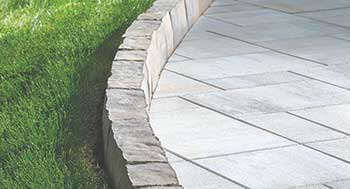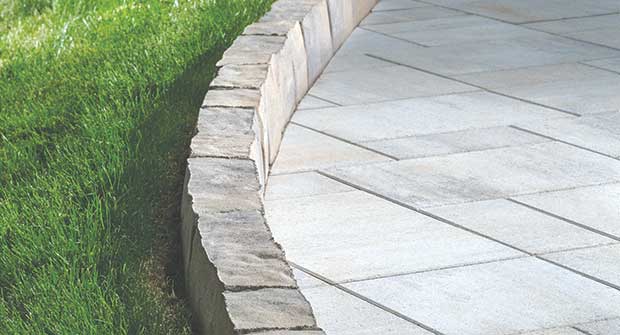
When it comes to hardscape edging trends, they are often a byproduct of a change in other hardscaping techniques. Such is the case with products including Perma Paver Edging, says Beau Rosso, commercial design consultant for northern Ohio with Unilock.
Rosso and Joe Raboine, director of residential hardscapes for Belgard, share some hardscape edging trends that could influence designs and maintenance in the coming year.
Structural edge restraints
The first trend, Rosso says, is the introduction of structural edge restraints due to the use of an open-graded aggregate in base preparation. Structural edge restraints are similar to concrete but include a blend of additives that allows the edging to be more flexible.
“Base preparation is starting to be a bit different than it has (been) in the past,” he says. “That base is now like a reservoir and the void space is typically 30 or 40 percent. With this type of base preparation, you cannot pound a spike into the aggregate because it just moves around.”
Rosso says permeable pavers stand up quite well in climates with freeze-thaw cycles, and because of this, contractors have started to take notice.
“What contractors have realized is these installations are holding up really well,” he says. “‘Why don’t we do this now on those backyard settings?’”
Rosso says the lack of labor is a big influence on contractors choosing structural edge restraints. For example, Perma Paver Edging says a 50-foot installation of their product can take as little as 3-5 minutes. This interest in structural edge restraints has become even more popular with the introduction of products including SEK Surebond’s EdgeCrete and Polybind’s Gator Xtreme Edge to go along with Perma Paver Edging’s original product.
“When it comes to the troweled-in products like a Perma-Edge, EdgeCrete or Extreme Edge, we’re trying to eliminate the maintenance requirement,” he says. “With the ease of installation and the longevity of these products, we are hoping to make contractors more efficient and more profitable on their job sites.”
Modular design
While curvilinear designs remain popular in the U.S., Raboine says the influence of modular designs continues to grow in the U.S. in hardscapes, and with that comes a new look at hardscape edging. In Europe and Canada, concrete curbs are part of the overall hardscape design. He sees this trend taking off in the U.S. The advantages of raised edging include directing the flow of water, eliminating erosion and preventing debris from washing over the pavement.
“Water would hit that 4-inch raised curb unit and move down to the street,” he says. “It helps prevent erosion, and it just creates more structure to the yard or landscape.”
Belgard offers a 10-inch-tall raised edger, Anglia. To secure the edger, contractors bury it a couple of inches deep.
“You can excavate and place it on a little bit of sand or finely crushed quarter-inch screenings as a base to help level things,” Raboine says. “The sheer weight of that doesn’t require anything else. You place it, bury it 2 to 3 inches, you backfill both sides, and that thing is not going anywhere.”
A key way for contractors to sell the raised curb to clients is to stress the benefits from a maintenance standpoint as it can help keep pavers clean.
“Long term, it should really cut down on maintenance and keep things neat and tidy and crisp looking,” he says. “I’m sure that would be really appealing.”


